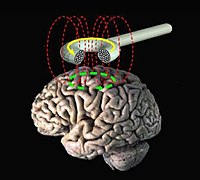
Photo from wikipedia
Noninvasive brain stimulation (NIBS) allows to actively and noninvasively modulate brain function. Aside from inhibiting specific processes, NIBS may also enhance cognitive functions, which might be used for the prevention… Click to show full abstract
Noninvasive brain stimulation (NIBS) allows to actively and noninvasively modulate brain function. Aside from inhibiting specific processes, NIBS may also enhance cognitive functions, which might be used for the prevention and intervention of learning disabilities such as dyslexia. However, despite the growing interest in modulating learning abilities, a comprehensive, up-to-date review synthesizing NIBS studies with dyslexics is missing. Here, we fill this gap and elucidate the potential of NIBS as treatment option in dyslexia. The findings of the 15 included studies suggest that repeated sessions of reading training combined with different NIBS protocols may induce long-lasting improvements of reading performance in child and adult dyslexics, opening promising avenues for future research. In particular, the "classical" reading areas seem to be most successfully modulated through NIBS, and facilitatory protocols can improve various reading-related subprocesses. Moreover, we emphasize the need to further explore the potential to modulate auditory cortex function as a preintervention and intervention approach for affected children, for example, to avoid the development of auditory and phonological difficulties at the core of dyslexia. Finally, we outline how future studies may increase our understanding of the neurobiological basis of NIBS-induced improvements in dyslexia.
Journal Title: Human brain mapping
Year Published: 2021
Link to full text (if available)
Share on Social Media: Sign Up to like & get
recommendations!